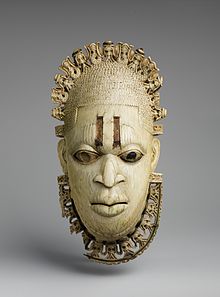Benin ivory mask

This 16th century ivory portrait of Queen Mother Idia is among The Met's most celebrated works. It is one of four related ivory pendant masks, that were among the prized regalia of the Oba of Benin, among the prestige items taken by the British during the punitive expedition of 1897.
|
|
| Material | Ivory, iron inlay |
|---|---|
| Height | 9 3/8 in (23.8 cm) |
| Width | 5 in (12.7 cm) |
| Depth | 3 1/4 in (8.3 cm) |
| Created | Early 16th century |
| Present location | Metropolitan Museum of Art, British Museum, Seattle Art Museum, Linden Museum, private collection |
The Benin ivory mask is a miniature sculptural portrait in ivory of the powerful Queen Mother Idia of the 16th century Benin Empire, taking the form of an African traditional mask. The likeness was worn however, not as a mask, but as a pendant by her son Esigie, who owed his kingship as Oba of Benin to the Queen Mother's military aid.
Two almost identical masks are extant: one at the British Museum in London and the other at the Metropolitan Museum of Art in New York City. Both feature a serene face of the Queen Mother wearing a beaded headdress, a beaded choker at her neck, scarification highlighted by iron inlay on the forehead, and all framed by the flange of an openwork tiara and collar of symbolic beings, as well as double loops at each side for attachment of the pendant.
There are also examples on the same theme at the Seattle Art Museum and the Linden Museum, and one in a private collection, all taken during the British Benin Expedition of 1897.
The British Museum example in particular has also become a cultural emblem of modern Nigeria since FESTAC 77, a major pan-African cultural festival held in 1977.
In the early 16th century, the dynamic Esigie ruled the Benin Empire of the Edo people as its Oba. He came to power as Portuguese explorers first made contact with the empire. Trade and diplomacy with Europe brought Esigie and the Edo prosperity and regional influence as the empire traded pepper, ivory, local textiles, and slaves for brass, cloth, coral beads, and mercenaries for protection. Esigie engaged in two major conflicts. First, his half-brother fought a protracted civil war over the line of succession that would crown Esigie, the firstborn. Second, Esigie successfully defended against an invasion from the northern Igala Kingdom and captured their leader. Esigie rewarded his key political and mystical advisor during these trials, his mother Idia, with the title of Iyoba (Queen Mother)—the first in a tradition of Queen Mother advisors. The identification with Idia was made by Oba Akenzua II in the mid-20th century.
...
Wikipedia
